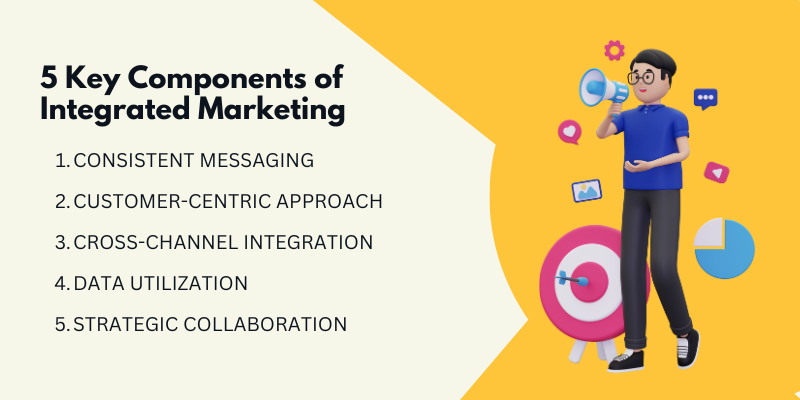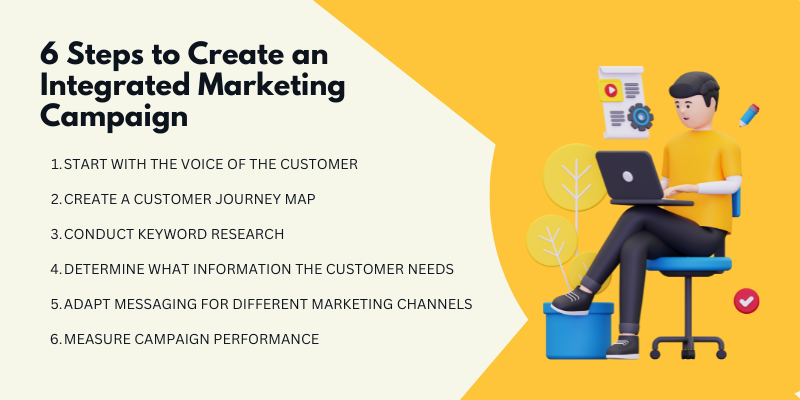What is integrated marketing? It is a strategic approach that ensures every marketing channel works together to deliver one clear and consistent brand message.
In today’s fast-paced digital world, customers interact with brands across multiple platforms from social media and email to print ads and in-store promotions.
Integrated marketing connects all these efforts, creating a seamless and unified customer experience.
Instead of treating each marketing effort as a separate campaign, integrated marketing aligns advertising, public relations, digital marketing, and sales around the same goal and message. This coordination helps brands reinforce their identity, build trust, and make a lasting impression on their audience.
For example, when a company launches a new product, it might run social media ads, send promotional emails, publish blogs, and display physical banners all carrying the same visuals, tone, and message. This consistency increases recognition and strengthens the overall impact.
In this blog, we’ll explore everything you need to know about integrated marketing.
What is Integrated Marketing?
Integrated marketing is a strategy focused on aligning all of a brand’s messaging and communications across various channels to create a cohesive experience for the customer.
By integrating digital marketing services, brands can ensure their message resonates with the target audience across different platforms, increasing overall engagement and visibility.
Officially referred to as Integrated Marketing Communications (IMC), this approach emphasizes meeting customer needs rather than concentrating solely on internal sales targets.
3 Key Principles of Integrated Marketing
- Customer-Centric Communication: The strategy prioritizes communication based on customer needs and interests, rather than focusing on company-driven sales goals.
- Building Relationships: Integrated marketing aims to foster long-term relationships with customers by creating consistent, meaningful interactions through all marketing channels.
- Consistency Across Channels: The idea is to ensure that all touchpoints, whether digital, physical, or social, carry the same brand message and tone. This consistency helps strengthen brand identity and trust.
The Origins of Integrated Marketing
The concept of integrated marketing can be traced back to the late 1980s and is often attributed to Don E. Schultz, a professor emeritus at Northwestern University. Schultz's work in marketing communications emphasized the importance of delivering a unified message across all channels, even before the rise of the internet.
Integrated Marketing vs. Omnichannel Marketing
Omnichannel marketing aims to reach potential customers across all channels they use during their journey. However, network marketing tends to focus on the distribution of information by personal connections, which can complement omnichannel efforts by adding an additional level of trust and relatability.
It uses advanced technologies like ad servers and programmatic advertising to target the same IP address everywhere.
However, it doesn't always ensure consistent messaging or personalized content at each touchpoint.
In contrast, integrated marketing is a strategy that focuses on consistent, buyer-centric messaging across all touchpoints. It can be applied within an omnichannel approach, ensuring that the message is not only consistent but also personalized to the customer.
Integrated marketing adds a layer of intentionality, making campaigns more effective and efficient.
Explore Our Digital Marketing Services!
Example of Integrated Marketing: Pool Toy Business
Imagine you sell pool toys. A traditional marketing approach might have you placing ads next to content about "swimming pools."
However, if the articles focus on building a pool, your pool toy ad may not perform well because the audience isn’t yet thinking about buying toys.
With an integrated marketing strategy, you would take a more strategic approach, integrating growth marketing techniques to better understand seasonal trends and consumer needs, ensuring your ads reach the right audience at the right time.
- Audience Segmentation: Work with the publisher to segment readers who have read multiple pool-related articles, indicating they’re interested in building a pool.
- Timing Ads: Rather than showing ads immediately, serve pool toy ads three months later when these users are more likely to buy toys for their pool.
- Broader Reach: Instead of targeting just the “swimming pool” keyword, expand to readers engaging with water recreation or summer activity content, ensuring your message is timely and relevant.
This strategy ensures your marketing messages align with customer needs and timing, leading to better engagement and results.
5 Key Components of Integrated Marketing
Key components of integrated marketing ensure that all marketing efforts work together through consistent messaging, multi-channel coordination, and a customer-centric approach. This approach is critical for digital marketing agencies like Centric, which specializes in crafting unified campaigns that improve brand consistency across all touchpoints.

- Consistent Messaging: Ensure that all marketing materials and communications share a unified message across all channels, creating a cohesive brand image.
- Customer-Centric Approach: Focus on understanding and addressing customer needs and preferences, rather than just pushing sales-driven content.
- Cross-Channel Integration: Align marketing efforts across various platforms, digital, print, social media, email, and more, so customers receive a seamless experience regardless of the touchpoint.
- Data Utilization: Use customer data and insights to personalize messages and make informed decisions, enhancing the relevance of campaigns.
- Strategic Collaboration: Work across departments and with external partners to ensure that marketing, sales, and customer service efforts are aligned and working toward common goals.
These components work together to create a unified, effective marketing strategy that builds strong customer relationships and enhances brand trust.
Top 6 Benefits of Integrated Marketing
Integrated marketing offers several key advantages that help brands maintain consistency, strengthen customer relationships, and achieve better results. This is particularly important in B2B marketing, where long-term relationships and a unified brand message are vital for retaining clients and building trust.
- Stronger Brand Identity: Consistent messaging across all channels helps reinforce brand recognition and trust.
- Higher Engagement: Unified campaigns create a smoother customer experience, leading to deeper audience interaction and loyalty.
- Cost Efficiency: Coordinating efforts across platforms reduces duplication and maximizes the impact of marketing spend.
- Measurable ROI: Centralized tracking and analytics make it easier to measure performance across campaigns and channels.
- Improved Customer Experience: Seamless communication ensures customers receive clear, relevant messages at every touchpoint.
- Better Team Alignment: Marketing, sales, and PR teams work toward shared goals with a unified strategy and vision.
Explore Our Performance Marketing Services!
How to Create an Integrated Marketing Campaign?
Creating an integrated marketing campaign involves aligning all of your marketing efforts to deliver a consistent, personalized, and seamless experience to your customers.
Additionally, understanding how to measure brand awareness is crucial in evaluating the effectiveness of your campaigns across multiple channels.
It’s not just about reaching your audience through multiple channels; it’s about crafting messages that resonate with them at the right time and place, fostering a deeper connection.

Here’s how to build a successful integrated marketing campaign:
- Start with the Voice of the Customer: Understand your customers' needs, preferences, and pain points. This will guide your messaging and ensure it resonates with your target audience.
- Create a Customer Journey Map: Outline the steps your customer takes from awareness to purchase. This helps identify the best touchpoints to engage with them throughout their journey.
- Conduct Keyword Research: Identify relevant keywords that your audience is searching for. This will help optimize your content for search engines and improve visibility.
- Determine What Information the Customer Needs: Understand what information or value the customer is looking for at each stage of their journey. Provide content that answers their questions and solves their problems.
- Adapt Messaging for Different Marketing Channels: Customize your message to fit each platform (e.g., email, social media, website, ads) while maintaining a consistent core message across all channels.
- Measure Campaign Performance: Track key metrics like engagement, conversion rates, and ROI to assess the effectiveness of your campaign and make necessary adjustments.
What Are The Challenges In Integrated Marketing?
While integrated marketing is highly effective, it comes with several challenges that businesses must manage carefully to ensure campaign success.
One of the most pressing concerns is determining if digital marketing is legit, as some businesses still struggle to understand how digital channels can integrate with their traditional marketing methods.
The process involves aligning multiple channels, teams, and technologies, which can often lead to communication gaps or inconsistent execution.
Some of the main challenges include:
- Cross-Team Coordination: Managing collaboration between marketing, sales, PR, and design teams can be complex. Without proper alignment, messaging and goals may become inconsistent.
- Maintaining Brand Tone and Consistency: With different teams producing content across various platforms, keeping a unified voice, tone, and visual identity can be difficult. Strong brand guidelines are essential.
- Tracking Multi-Channel Performance: Measuring the impact of each channel, like social media, SEO, email, and paid ads, requires integrated analytics tools to track conversions and ROI accurately.
- Data and Technology Integration: Combining data from different systems (CRM, analytics, social platforms) can be technically challenging, leading to fragmented insights.
- Resource Management: Coordinating multiple campaigns simultaneously often requires more time, budget, and skilled personnel than single-channel efforts.
Conclusion
What is integrated marketing and why does it matter for long-term success? In conclusion, integrated marketing plays a crucial role in achieving long-term brand success by ensuring message consistency and a unified customer experience. For specialized industries like oil and gas marketing agencies, this approach helps streamline communication and solidify their market presence across various platforms. When all marketing channels digital, print, and in-person work together under a single strategy, the brand’s voice remains strong and recognizable. This alignment not only improves customer trust but also enhances engagement and loyalty over time. By implementing an effective integrated marketing approach, businesses can connect with audiences more meaningfully, reduce message confusion, and optimize their marketing efforts for better results. It helps brands maintain clarity, build credibility, and achieve measurable growth making integrated marketing an essential part of every modern business strategy.








